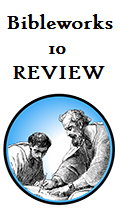Part 1 of this review series looked at BibleWorks 10’s design and interface, highlighting its simplicity but also warning those with high-res devices. This post will focus on BW 10’s new features, some of which are simple but extraordinarily helpful.
One feature I’m excited about is the “Forms” tab. When you hover over a Greek, Hebrew, or Aramaic word, the forms tab will show you every form of that word that appears in that textual version. I’ve used this many times already while teaching Greek to find, e.g., the difference between aorist and perfect forms, stem changes, and other irregularities that are difficult to look up in books. It’s such a simple, but powerful feature that will help improve your language in a bit way if you use it rightly.
BW 9 was the first version to include high-def photos of manuscripts, and many of them were morphologically tagged and searchable. BW 10 retains this feature, which comes with the three major manuscripts Sinaiticus, Alexandrinus, and Vaticanus, as well as a few others. Since they are morphologically tagged, you can choose any of these manuscripts as your “browse” version and then do morphological searches on them just like you would with the standard Hebrew and Greek versions! The ability to see these manuscripts from my computer is amazing. In my dissertation I have a section on Eph 1:1 and the phrase “in Ephesus,” which is lacking in the earliest manuscripts. How much easier can textual criticism get from my laptop than to open these three early witnesses and see what’s written?
Look at Ephesians 1:1 below in Sinaiticus. The scribe shortened εἰσίν to εἰσι, and when I check the “Forms” tab for εἰμί, I see that the form with the nu occurs 427 times in the NT + LXX, while the shortened form here occurs only 8 times. (Kink for BW: When I click the form of the word, it doesn’t open up the sentences that contain that form, but the sentences with all the forms, so I would have to hunt down those 8 occurrences among the 427 verses displayed.) There may be no significance to the shortened version here, but τοίς εἰσίν is the phrase that is questionable because of its awkward grammar (“the saints who are, and the faithful in Christ..”), so perhaps there’s something to it.

Screenshot 2: Ephesians 1:1 in Sinaiticus
More importantly, note on the fourth left, “έν Έφέσῳ” is written in the left margin, showing that the phrase is likely also a marginal note in whatever text(s) this scribe copied from, or at least wasn’t integrated smoothly as to look original. Being able to conduct this sort of text-critical analysis using high-def images of Greek manuscripts is a dream come true, and former generations of text-critical scholars might be rolling over in their grave!
This feature of @BibleWorks 10 might have text-critical scholars rolling in their graves! Share on XBut the greatness doesn’t stop there. BW 10 has added full images of Leningradensis manuscripts of the Old Testament. What! Yes, there it is, בראשׁיתבראאלהימ! For those of who you like to try to read from manuscripts, BW 10 is now an incredible program. I purchased the Dead Sea Scrolls Sectarian texts package a while back for some coursework and I enjoyed using the morphologically tagged text, but I did all my translation and text-critical work on 1QM from high-def images here. I got a good feel for the scribe’s tendencies, for Qumran orthography, and was able to see the breaks in the manuscripts (on which much has been written). Now that BW 10 is adding so many important manuscripts to the program for us to be able to read directly from them, I expect I’ll be doing much more of my Greek and Hebrew reading from these ancient manuscripts.
@BibleWorks 10 added full images of Leningradensis manuscripts of the OT! Share on XI’m afraid if I continue on at length about these features, this post will run too far, so let me summarize some of the other great features available only in this version.
- They added a user lexicon, which allows you to keep research on specific words in one file (which opens in the Analysis window “UserLex” tab), rather than keeping notes on that word in your “Notes” tab on a specific verse in which it occurs.
- They added NA28 and updated Leedy’s NT Greek diagrams, which I use constantly when doing exegesis or when I teach.
- If you’ve never been to the Holy Land (like me), you can find many images of Israel in Resources –> Pictures –> BibleViews. I would post a screenshot, but that may violate something.
- You get another Greek lexicon, Danker’s frequently used Concise Greek–English Lexicon of the New Testament
- There is also the Friberg Analytical Greek New Testament tab in the Analysis window, which provides an interlinear display of the AGNT text, including several new lines such as English reference glosses, phrasal glosses and documentation links (screenshot 4). However, the text is incredibly small for my computer and the lines nest into one another, a problem I highlighted in our first post for those of us with high-res screens. When you hover your mouse over a word, the explanation in the bottom half of the Analysis column, but my computer thought the words were in all the white space, so there is some sort of issue here that needs to be sorted out.
There are many other features and text versions that are new to BW 10, and there are some new Greek and Hebrew packages you can buy as add-ons. You can check them all out here on BibleWorks’ website. I’ve highlighted in this post a few of the features I find to be the most exciting and useful, but with so many features to highlight surely the other features will be just as exciting to other students, pastors, and scholars.
Find BibleWorks 10 here on Amazon.




